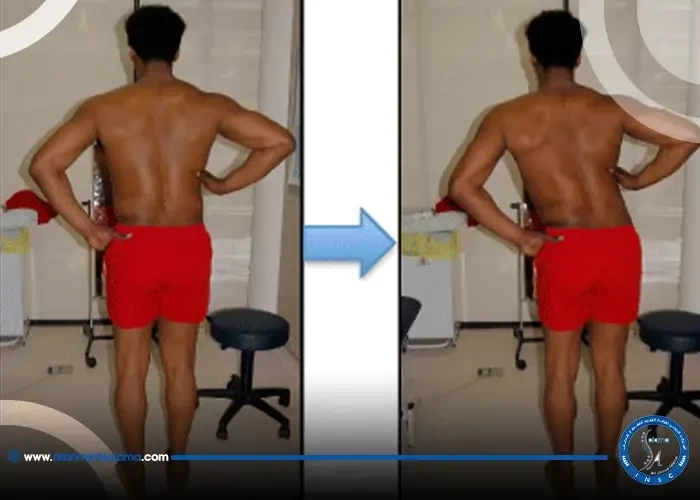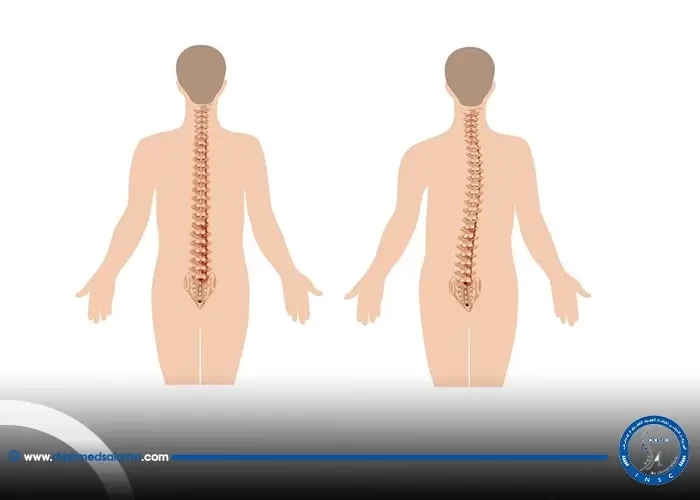Nasr City, 52 El Tayaran Street, in front of the Health Insurance Hospital

The correct way to sleep for patients with herniated disc

The correct sleeping position for patients with a herniated disc is not just a matter of comfort. It is an essential step in protecting the spine and supporting treatment by alleviating chronic pain resulting from herniated discs in the neck or lumbar vertebrae, or even sciatica and lower back pain.
In this article, we will learn about the correct sleeping position for patients with a herniated disc in detail, including the benefits of placing a pillow under the back to relieve pressure on the vertebrae. We will also provide advice for patients with a herniated disc in the lumbar region. We will also show you the correct sleeping position for the neck (with pictures), as well as the correct sleeping position for patients with sciatica, and other details. Just keep reading.
The Correct Sleeping Position for Patients with a Herniated Disc
Patients with a herniated disc suffer from chronic pain that may affect the quality of sleep and increase their feelings of fatigue. Choosing the correct sleeping position for patients with a herniated disc helps relieve pressure on the vertebrae and improve nighttime comfort, and is an essential step in the treatment plan for a herniated disc. Sleeping techniques can be explained according to the type of herniation as follows:
The correct sleeping method for patients with a herniated cervical disc
To maintain neck health and relieve pain and pressure on the cervical vertebrae, one of the following correct sleeping techniques can be followed for patients with a herniated cervical disc:
Sleeping on your back, with your head and neck placed on a comfortable pillow to support the cervical vertebrae and distribute weight evenly across the spine.
Sleeping on your side using a wide pillow keeps your head and neck aligned with your spine throughout the night.
Avoid sleeping on your stomach. However, if you are unable to sleep in any other position, you can use a thin pillow under your neck or sleep without a pillow to keep your spine aligned and avoid neck twisting.
Sleeping in a sitting position is beneficial for some patients, such as pregnant women or those who find this position comfortable. A pillow should be placed around your neck and lower back to support alignment and reduce pressure.
The Correct Sleeping Position for Lumbar Disc Herniation Patients
Adhering to the correct sleeping position for patients with lumbar disc herniation helps relieve pain and pressure on the lumbar vertebrae. These positions include:
Sleeping on one side with the knees slightly bent (the fetal position) to maintain spinal alignment.
Placing a pillow between the knees to reduce pressure on the lower back and pelvis.
Lying on your back with a pillow under the knees to support the natural curvature of the spine.
It is preferable to avoid sleeping on your stomach. If you must, use a thin pillow under the abdomen and hips to reduce pressure on the lumbar vertebrae, while reducing the height of the pillow under your head.
Although the correct sleeping position for lower back and neck pain caused by a herniated disc is effective in relieving pain and improving quality of life, it is not a substitute for specialized medical treatment. Therefore, do not hesitate to consult Dr. Ahmed Ibrahim Salama, a consultant neurosurgeon and spine surgeon, to obtain a safe and effective treatment plan tailored to your condition.
Benefits of Placing a Pillow Under the Back for Patients with a Herniated Disc
Adopting the correct sleeping position for patients with a herniated disc is one of the easiest and most effective ways to reduce pressure on the spine and improve sleep comfort for patients with a herniated disc. It also supports the cervical and lumbar vertebrae and helps distribute body weight evenly during sleep. The benefits of placing a pillow under the back for patients with a herniated disc include:
Reducing pressure on the lower back and lumbar vertebrae.
Maintaining the natural curvature of the spine while lying down.
Reducing herniated disc pain and improving sleep quality.
Supporting the muscles surrounding the spine and reducing muscle tension.
Enhancing blood circulation during sleep.
Preventing the worsening of herniated discs and chronic lower back pain.
Promoting mental and physical relaxation at night.
Contributing to the prevention of pain resulting from incorrect sleeping positions.
In general, this method helps reduce pain and promote relaxation. However, it remains a complementary method as part of a treatment plan, not a substitute. Therefore, do not hesitate to consult Dr. Ahmed Ibrahim Salama to develop a comprehensive treatment plan that suits your condition.
Advice for Lumbar Disc Herniation Patients
Following some daily tips is an essential step to maintaining back comfort and relieving pain caused by a herniated lumbar disc. Although these tips do not directly treat a herniated lumbar disc and may seem simple, they are effective in relieving pressure on the lumbar vertebrae while reducing the need for surgical intervention. The most important advice for lumbar disc herniation patients includes:
Avoid sitting or lying down for long periods in one position to reduce pressure on the spine.
Follow the recommended sleeping position for lumbar disc herniation patients to support the natural curvature of the back.
Use warm compresses on the painful area to increase blood flow and reduce muscle spasms.
Take pain relievers as needed or anti-inflammatory injections after consulting your doctor.
Follow the correct sitting position to support the spine.
Perform exercises recommended by your doctor to strengthen your back and abdominal muscles.
Avoid lifting heavy objects incorrectly and rely on your thigh muscles instead of bending your spine.
Gradually return to daily activities with caution.
The Correct Sleeping Method for Sciatica Patients
Now that we've learned about the correct sleeping method for patients with a herniated disc, sciatica is also a condition that requires attention to sleeping positions to relieve pain and improve nighttime comfort. Although sleep alone doesn't treat sciatica, following the correct sleeping method for sciatica patients helps relieve pressure on the lumbar vertebrae and reduce the severity of symptoms. Sleeping methods for these conditions include:
Sleeping on your back straight: Keep your head, neck, shoulders, and buttocks in a straight line, with a pillow under your head and neck. A small pillow can be placed under your knees to relieve pressure on your lower back.
Sleeping in the fetal position: Lie on your side with your knees bent toward your chest, and use a pillow between your knees to relieve pressure on your spine.
Sleeping on your side: Choose the unaffected side and place a pillow between your waist and the mattress to fill the gap and achieve better spinal alignment.
Sleeping on the floor: Use a thin mattress and lie on your back or in any comfortable position to strengthen your spine and relieve pressure on the sciatic nerve.
Adopting the correct sleeping position for lower back pain caused by sciatica helps relieve pain and improve sleep quality. However, it remains a complementary part of the treatment plan and does not replace specialized medical advice. Therefore, do not hesitate to book a consultation with Dr. Ahmed Ibrahim Salama to receive an accurate diagnosis and comprehensive treatment for your condition.
The Correct Sleeping Position for the Neck (with Pictures)
Many patients with a herniated disc search for the correct sleeping position for the neck (with pictures) to understand the positions that help relieve pain and support the cervical spine. These pictures illustrate the correct sleeping position for patients with a herniated disc in the neck, including placing the pillow properly to maintain head and neck alignment, whether sleeping on the back or on the side. This enhances nighttime comfort and supports the correct sleeping position for lower back or neck pain.
Why choose Dr. Ahmed Ibrahim Salama for herniated disc treatment?
Dr. Ahmed Ibrahim Salama, a consultant neurosurgeon and spine surgeon, is the ideal choice for treating herniated discs, given his extensive years of experience in treating various herniated disc cases with high precision. Dr. Ahmed relies on the latest diagnostic and treatment techniques, both non-surgical and surgical, while developing a personalized treatment plan for each patient based on their condition.
Dr. Ahmed Salama also closely monitors patients after treatment to ensure sustained movement and pain reduction. He also pays great attention to providing advice and guidance on daily living, including proper sleeping positions for the neck and back, ensuring long-term stability and improved quality of life.
Finally, it's worth noting that adopting the correct sleeping position for patients with a herniated disc is not a direct treatment for the condition, but it is an important and necessary step in supporting the treatment plan. It helps relieve pressure on the vertebrae, improve nighttime rest, and maintain spinal alignment. Combining these tips with Dr. Ahmed Ibrahim Salama's expertise, patients receive a comprehensive treatment experience that provides greater comfort and promotes a safe and effective recovery
Is walking harmful for patients with a herniated disc?
Walking is beneficial for patients with a herniated disc if done moderately and regularly. It strengthens the muscles surrounding the spine, improves flexibility, and enhances blood circulation. However, walking for long periods or on uneven surfaces should be avoided to avoid increased pressure on the vertebrae. Consulting a doctor is essential to determine what is appropriate for each case.
What are the correct sitting instructions for patients with a herniated disc?
It is recommended to sit with your spine straight, support your lower back with a small pillow if needed, and place your feet flat on the floor. Also, avoid bending forward or sitting for long periods without moving.






